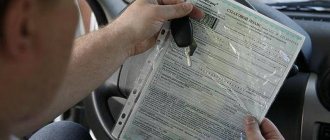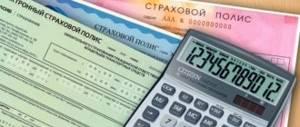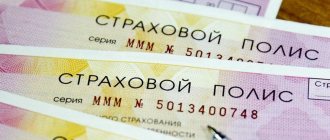On April 1, 2015, new territorial OSAGO coefficients came into effect, and on April 12 of the same year, basic tariffs came into effect. After this innovation, policies increased in price by an average of 40% and many owners are afraid of a further increase in prices for compulsory motor liability insurance.
In this article we will look at what the cost of compulsory motor liability insurance depends on and how the tariff system for pricing an insurance policy has changed over time? What are the prospects in this direction and is it true that the only reason for the constant increase in prices is the desire of insurers to earn more?
What is the base rate?
The cost of an MTPL policy is calculated based on a number of fixed variables, the main one being the so-called base rate.
The basic tariff is understood as a legally established amount, on the basis of which the cost of the policy is subsequently determined by applying various coefficients. The basic cost is the same for all citizens of the country, regardless of region, driving experience and other individual parameters. The only parameter that is taken into account when calculating the basic tariff is the type of vehicle; for example, for a truck this figure is 1.5 times higher than for a passenger car.
According to the law (No. 40-FZ dated April 25, 2002), all powers to regulate basic tariffs are vested in the Central Bank of the Russian Federation. Since the introduction of the first MTPL rate in 2003, it has remained unchanged for a long time. In determining its value, the regulator was primarily guided by the principle that the amount of money collected by companies from the sale of policies should exceed the costs of paying insurance premiums.
The first increase in the base tariff occurred in October 2014. It was due to the fact that over many years, during which the rate did not change, while the economic situation had seriously changed and, taking into account inflation, the funds received by organizations from the sale of policies were simply no longer enough to cover payments for insured events. As it turned out later, the new prices did not last long, and their increase itself was one of the urgent measures to stabilize the car insurance market. A full revision of prices and the establishment of new base rates for compulsory motor liability insurance policies from April 1, 2015 at the time of publication of the instruction of the Central Bank of the Russian Federation No. 3604-U.
The principle of calculating the cost of an MTPL policy in 2021
Today, pricing for compulsory motor liability insurance is regulated by the Central Bank, which, in essence, is the guarantor of stability and control. The Central Bank determines both the maximum values of the base rate of the insurance tariff and the tariff coefficients. In this case, insurance companies have the right to choose the value of the base rate from the range proposed by the Central Bank (for passenger cars operated by individuals or individual entrepreneurs, it is 3432-4118 rubles).
Large companies, key players in the insurance services market, as a rule, choose the maximum value – 4118 rubles – as the basis. Considering that the tariff coefficients established by the Central Bank are the same for all companies, the prices for policies are practically the same. And indeed, if you go to the websites of the companies Alfastakhovanie, RESO Garantiya, VSK, Ingosstrakh, Renaissance, etc. and use a calculator to calculate the cost of compulsory motor liability insurance, you will get the same values.
To determine the cost of the policy, the following coefficients are used:
- coefficient of the territory of operation of the vehicle - CT;
- “bonus-malus”, determined by the number of insured events per year - KBM;
- number of drivers allowed to drive vehicles - KO;
- age and experience of the driver - PIC;
- technical characteristics of the vehicle (engine power) - KM;
- availability of trailer - gearbox;
- policy period of use – KS.
The cost is equal to the product of the base value and the applied coefficients.
OSAGO = (basic tariff)*KT*KBM*KO*KVS*KM*KPr*KS
Today, the operating territory coefficient is most often calculated in accordance with the place of residence (registration locality) of the car owner, which is a unique way for many motorists to receive a discount on an MTPL policy. So, for example, if a car owner is registered in the Leningrad region, but operates a car in St. Petersburg, when calculating the price of compulsory motor liability insurance, a coefficient of 1.3 will be used, and not 1.8, as for those who are registered in the northern capital. In small regional cities the coefficient is 0.7-09, i.e. the policy price may be lower than the base value.
| City | Coefficient |
| Ufa | 1.8 |
| Nalchik | 1 |
| Simferopol | 0.6 |
| Kazan | 2 |
| Anapa, Gelendzhik | 1.3 |
| Armavir, Sochi, Tuapse | 1.2 |
| Krasnoyarsk | 1.8 |
| Kaliningrad | 1.1 |
| Leningrad region | 1.3 |
| Moscow region | 1.7 |
| Tver | 1.5 |
| Tomsk | 1.6 |
| Tula | 1.5 |
| Tyumen | 2 |
| Chelyabinsk | 2.1 |
| Yaroslavl | 1.5 |
| Moscow | 2 |
| Saint Petersburg | 1.8 |
| Sevastopol | 0.6 |
The full list of territory coefficients is given in the Central Bank Directive dated September 19, 2014 N 3384-U in the current version.
The KBM depends on the class at the beginning of the insurance period. New motorists are assigned class 3 with a coefficient of 1, which, based on the formula, does not affect the cost of compulsory motor insurance. In the future, in the absence of insurance compensation (IC) for the current period (year), the class rises to 4 with a coefficient of 0.95. If there was 1 SV, the class is reduced to 2 with a coefficient of 1.4, which increases the cost of compulsory motor liability insurance by 40%. If two or more drivers are included in the insurance, compulsory motor liability insurance is calculated according to the highest KBM.
| Class at the beginning of the period | Coefficient | Class at the end of the period | ||||
| 0 NE | 1 SV | 2 SV | 3 NE | More than 3 SV | ||
| M | 2,45 | 0 | M | M | M | M |
| 0 | 2,3 | 1 | M | M | M | M |
| 1 | 1,55 | 2 | M | M | M | M |
| 2 | 1,4 | 3 | 1 | M | M | M |
| 3 | 1 | 4 | 1 | M | M | M |
| 4 | 0,95 | 5 | 2 | 1 | M | M |
| 5 | 0,9 | 6 | 3 | 1 | M | M |
| 6 | 0,85 | 7 | 4 | 2 | M | M |
| 7 | 0,8 | 8 | 4 | 2 | M | M |
| 8 | 0,75 | 9 | 5 | 2 | M | M |
| 9 | 0,7 | 10 | 5 | 2 | 1 | M |
| 10 | 0,65 | 11 | 6 | 3 | 1 | M |
| 11 | 0,6 | 12 | 6 | 3 | 1 | M |
| 12 | 0,55 | 13 | 6 | 3 | 1 | M |
| 13 | 0,5 | 13 | 7 | 3 | 1 | M |
KO is equal to either one (if the number of people driving a car is limited) or is 1.8 (if there are no restrictions).
Today, the coefficient depending on the age and experience of drivers does not affect the cost of compulsory motor liability insurance if the motorist is over 22 years old and the driver’s license was obtained more than 3 years ago (PIC = 1). The largest coefficient of 1.8 is determined for drivers under 22 years of age with 3 years or less of experience. The cost of the policy depends on age and driving experience and is planned to be reviewed in mid-2019.
Owners of cars with a more powerful engine also have to pay more for compulsory motor insurance. The highest coefficient of 1.6 applies if the car’s power is more than 150 horsepower.
| Engine power (hp) | KM |
| Up to 50 | 0.6 |
| 50 – 70 | 1.0 |
| 70 – 100 | 01.01.2018 |
| 100 – 120 | 01.02.2018 |
| 120 – 150 | 01.04.2018 |
| Over 150 | 01.06.2018 |
The cost of compulsory motor liability insurance for individuals with a trailer for a passenger car is not affected by the KPR coefficient, since it is equal to one.
When using a vehicle for several months a year, the cost of compulsory motor liability insurance is calculated using the KS. Thus, the price of a policy for a car that is used 6 months a year is 70% of the full cost (a coefficient of 0.7 is applied).
Tariff corridor from April 1, 2015
According to the above-mentioned instructions of the Central Bank of the Russian Federation, instead of a fixed base rate, a so-called tariff corridor was introduced, allowing companies to use any amount in the range from 3,432 to 4,118 rubles for the initial calculation of the cost of the policy. This decision was made based on the following considerations:
- To create competition in the MTPL market, and, as a result of competition, to improve the quality of auto insurance. When the rate was a fixed amount, the offers of most companies were not much different from each other, and the struggle for clients took place mainly only at the advertising level, since more serious steps in this direction were impossible, due to a clearly defined limitation in the price of the policy.
- Provide insurance organizations with flexibility in terms of setting prices for different categories of clients (individuals, individual entrepreneurs, pensioners, etc.) and different regions.
At the moment, it cannot be said that the measures taken are working effectively, since the price corridor is practically not used. Due to the long validity of the previous tariff system, the sale of MTPL policies was an unprofitable enterprise for many companies. In this regard, insurance organizations simply increased prices, basing their cost calculations on the new maximum allowable rate of 4,118 rubles (for example, Renaissance Insurance, Soglasie, Uralsib established such a rate in all regions of the Russian Federation, and SOGAZ, Ingosstrakh, VSK, AlfaStrakhovanie, RESO -Warranty in most regions).
How does the price corridor work in practice? Let's say we have a standard 120 hp machine. The owner of the car (over 22 years old) lives in Moscow, has over 3 years of driving experience, and has not previously been insured. Depending on the base rate, the price of an annual policy for a given vehicle can range from 8,236 to 9,883 rubles, that is, the difference is almost 20%.
The influence of age and experience
The price of compulsory motor liability insurance can be affected by any thing, even the most insignificant at first glance, including FAC. The abbreviation stands for “Age and Experience Coefficient”. To calculate it, information is taken from the driver's license. It always indicates the date of receipt of a driver’s license to drive a vehicle of a certain category. Driving experience is counted from this day. Naturally, those drivers who received their license upon reaching 18 years of age, that is, the age of majority, find themselves in a more advantageous situation. The dependence of the coefficient on the total driving experience and the driver’s age is shown in the table below.
That is, if the license was obtained at the age of 18, and the driver is, for example, 23 years old, he receives the most favorable coefficient.
Table of basic MTPL tariffs in 2021
The table below shows the basic rates for compulsory motor liability insurance in force in 2021.
| Vehicle type | Tariff corridor | |
| Min. amount, rub. | Max. amount, rub. | |
| Motorcycles, mopeds | 867 | 1 579 |
| Cars | ||
| For legal entities | 2 573 | 3 087 |
| For individuals | 3 432 | 4 118 |
| For taxi | 5 138 | 6 166 |
| Trucks | ||
| With a maximum weight of less than 16 tons | 3 509 | 4 211 |
| With a maximum weight of more than 16 tons | 5 284 | 6 341 |
| Vehicles for transporting passengers | ||
| With a number of passenger seats up to 16 inclusive | 2 808 | 3 370 |
| With more than 16 passenger seats | 3 509 | 4 211 |
| Trolleybuses | 2 808 | 3 370 |
| Trams | 1 751 | 2 101 |
| Tractors, self-propelled road construction machines | 1 124 | 1 579 |
Who regulates
In order to buy such a policy, you need to know what prices exist and how they are formed.
After all, one of the most important aspects in this matter is the base tariff rate, which is determined by the Central Bank of the Russian Federation. Confirmation that the Central Bank is authorized to make such decisions is the provision written in the law “On OSAGO”, in Art. 8th and paragraph 1 of Art. 9th (current law No. 40-FZ dated 2504.02, last amended on July 3, 2021).
Rates are set by the Central Bank in an actuarial way - by determining a specific range of tariffs within which insurance companies can choose the value of the base rate for their calculations of the cost of compulsory motor liability insurance policies that they sell.
The body that controls the activities of insurers also imposes its own requirements on them. One of these requirements is the payment of an insurance premium to clients in an amount that is not less than 80% of the total insurance.
This rule forces insurance companies to regularly pay all amounts due to policyholders and protects the latter from various tricks of insurers in terms of underpayments to their clients.
Other innovations of the Decree of the Central Bank of the Russian Federation No. 3604-U
It is worth noting that with the introduction of the order, not only the total cost of the policy increased, but also the maximum amount of insurance payments. If previously it was 120 thousand rubles for compensation for damage caused to property, and 160 thousand rubles for compensation for harm to life and health, then in 2021 the maximum payment limit would be increased to 400 and 500 thousand rubles, respectively.
Along with the adoption of the law on new tariffs, the Central Bank obliged all insurance companies to post and promptly update relevant information about the cost of the policy on their websites and online calculators. And in theory, any citizen, choosing the appropriate MTPL option for himself, can go online and check out the prices. However, in practice, most organizations hide the base rates page deep in the depths of their websites. Apparently, there is an unspoken agreement between insurers on this matter to counter dumping.
In addition to the new tariff rate, the Central Bank decree also provided for a change in regional coefficients. This parameter is determined for different regions based on the degree of road congestion and the average accident rate in the area. The highest coefficient is set for cities such as Murmansk, Chelyabinsk - 2.1; Kazan, Perm, Tyumen, Moscow, Surgut - 2. The cheapest new insurance will cost residents of regions such as the Chechen Republic, the Republic of Dagestan, Kalmykia, Crimea, Trans-Baikal Territory - coefficient 0.6.
Current rates in 2021 for individuals
Not every driver monitors changes in the conditions of the motor vehicle license for individuals. And not every car owner takes into account the importance of these changes, without thinking that sometimes small fly-by-night insurance organizations are looking for ways to deceive.
Only twice during its entire existence has the rate for compulsory motor liability insurance changed - in 2014 and in 2021.
In 2014, the base was considered to be 1980 rubles , and additional coefficients more than doubled the final cost. That is, the allowances were greater than the basic base. Today, a contract with an insurance organization will cost more for those drivers who live in regions with a high accident rate. The highest odds are in Moscow, and the lowest are in Volgograd.
The main increase in the bet amount was in 2021. The basic tariff was increased and ranged from 3,432 rubles to 4,118 rubles . The difference compared to previous years is quite significant, but it appeared for a reason: the corridor of payments for insurance claims has also increased significantly.
Most insurance organizations choose the maximum value as the basis for compulsory motor liability insurance in their calculations. This in 2021 led to an increase in the average cost of insurance for individuals by almost 30%. Considering that the maximum payment for insured events exceeds 400 thousand rubles , the innovations are fully justified.
KBM - accident-free driving coefficient
The table for calculating the KBM coefficient in the new Directive has remained virtually unchanged. However, changes have been made to the rules for applying this coefficient.
4. When determining the size of the CBM coefficient, the information contained in the automated information system of compulsory insurance, created in accordance with Article 30 of the Federal Law “On compulsory civil liability insurance of vehicle owners” (hereinafter referred to as AIS OSAGO), is used.
When determining the size of the CBM coefficient, each insurance claim and compensation payment made, information about which was registered during the CBM period in the AIS OSAGO, is taken into account.
To determine the CBM coefficient, insurance claims or compensation payments made by the insurer for one insured event are considered as one insurance claim.
If it is determined that the size of the CBM coefficient does not correspond to the information contained in the AIS OSAGO, the insurer applies the adjusted size of the CBM coefficient for the entire period of validity of the compulsory insurance contract in which the inappropriate size of the CBM was applied.
6. The KBM coefficient of a driver who is the owner of a vehicle - an individual, or a person allowed to drive a vehicle whose owner is an individual or legal entity, including cases where the compulsory insurance contract does not provide for a limitation on the number of persons allowed to drive a vehicle (hereinafter - The driver's KBM), in respect of which the AIS OSAGO contains information about compulsory insurance contracts, is determined on the basis of the value of the KBM coefficient, which was determined for the driver for the period of the KBM, and the number of insurance claims under all compulsory insurance contracts carried out by insurers in relation to this driver and registered in AIS OSAGO during the KBM period.
The KBM coefficient of a driver, information regarding which is not available in the AIS OSAGO, is set equal to 1.
The driver's BMC coefficient is determined annually for the period from April 1 to March 31 of the year following the year in which the BMC is determined, inclusive, is unchanged during the specified period of time and is applied to all compulsory insurance contracts that provide for the possibility of driving a vehicle by this driver and concluded during the specified period time.
Until April 1, 2021, the KBM coefficient changed after the MTPL agreement expired. That is, if during the contract there were no accidents due to the driver’s fault, then the coefficient decreased.
The new guidance states that the driver’s MSC is calculated for a MSC period equal to one year , but not the same as the calendar year. The CBM period begins on April 1 and ends on March 31 of the following year. That is, when calculating the CBM, the date of conclusion of the MTPL agreement does not matter.
The recalculation of the KBM occurs automatically on April 1 of each year.
However, it remains unclear how the CBM should be calculated if in the previous year the driver did not enter into any MTPL agreement.
More detailed information on the new rules for calculating KBM can be found in the following article:
Rules for calculating KBM from April 1, 2021
New coefficient for OSAGO 2021
It is planned that in 2021 another coefficient for “sloppy” drivers will come into effect. Its value will depend on previous traffic violations, such as a fine for not having a compulsory motor insurance policy or illegal parking. The main factor here will be the severity of the offenses, not their number. It will be applied for “repeat” driving through a red light or across a solid line, driving while drunk, etc. It is still unknown what values will be set for it, but one thing is clear: “bad” drivers risk receiving a significant markup on the policy.
Indicators affecting the cost of compulsory motor liability insurance
It should be noted that insurance rates are not taken out of the blue, but are the result of long and serious work by highly qualified scientific teams and unique specialization. The most important values when determining the final cost of the policy, in addition to the base rate, are the following specific parameters and characteristics:
- Subject of the Russian Federation where the vehicle is registered.
- Technical data and type of insured vehicle.
- Personal driving data of the insurance company client.
When calculating the insurance cost of compulsory motor liability insurance, some important parameters are taken into account - the age of the driver, his driving experience, the number of traffic offenses. Some of the listed factors are unchangeable, and some, like the traffic offenses mentioned, are completely dependent on the driver himself. Thus, and to some extent, the car owner himself can influence the monetary amount of the cost of insurance.
How is OSAGO calculated?
The general principle remains unchanged: the base tariff rate is multiplied by additional coefficients that can be applied to a specific driver and his car. The rate depends on the category of the vehicle and its purpose (car or other vehicle, car or truck, etc.).
There is no single rate - each insurer sets it themselves, the Central Bank only fixes the average value. The price may fluctuate within a 20 percent tariff corridor. The car insurance rate for an ordinary car ranges from 3,432 to 4,118 rubles; if you want to calculate the cost of compulsory motor liability insurance for your car, you will get different prices from different companies.
Previously, the corridor was narrower, and only grew to 20% in April 2015. However, this percentage is not final: it is expected that during 2021 or at the beginning of 2021 it will increase to 30. Ultimately, the expansion of the tariff corridor should lead to a transition to a free tariff, when insurers will set the rate independently, without relying on a fixed value.
Important! Even taking into account all the increases, the maximum cost of insurance is limited, and the price of the policy cannot be higher than the result according to the formula:
3 x base rate x territorial coefficient (TC).
Example: the base rate for a Moscow passenger car is 3725, and the TK is 2, then the maximum cost of compulsory motor insurance will be: 3725 X 3 X 2 = 22350.











